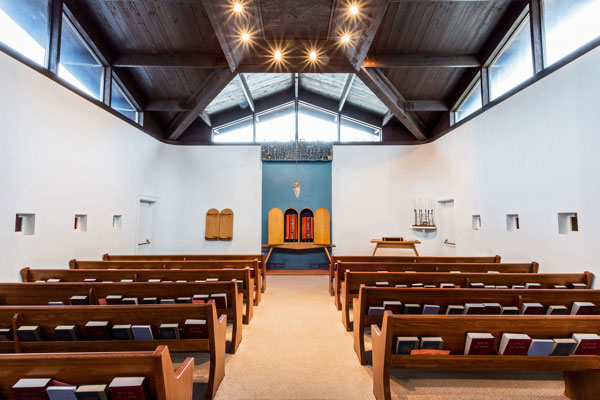Temple Beth El was erected during the suburban synagogue building boom of the 1940s and 1950s. Conservative and Reform congregations across the country were feeling a sense of pride and confidence, and they looked to modern design to signify a new progressive direction for their American Jewish identity.
Percival Goodman was considered the nation’s foremost designer of mid-century American synagogues. A Professor at Columbia University School of Architecture and Fellow of the American Institute of Architects and the International Institute of Arts and Letters, Goodman designed 60 synagogues in his lifetime. Goodman was renowned as a planner, artist, writer, social critic, environmentalist, teacher and designer. He envisioned multipurpose synagogues with fluid indoor-outdoor spaces that served the functions of the congregation—worship, study and social gathering—with an emphasis on natural light and materials. His pioneering designs have been highlighted in an exhibit at the National Museum of American Jewish History in Philadelphia.
Goodman’s design for Temple Beth El included soaring ceilings and golden windows meant to inspire worship. The small chapel was designed with simple white stucco walls and a rough wood ceiling, combining a Mediterranean style with a minimalist modern aesthetic.
Temple Beth El’s hallmark architecture is adorned by artwork of leading artists of the Modern American School, including Robert Motherwell, Adolph Gottlieb and Ibram Lassaw, each commissioned by Goodman to make art “for the purpose of religion.” A special exhibit at the Kootz Gallery in New York, entitled “Art for Synagogue,” showcased this innovative collaboration between architect and artist. The New York Times art critic Aline B. Louchheim praised the collaboration in a May 24, 1953 review: In October 1951, we praised the initial efforts of Gottlieb, Motherwell and Herbert Ferber for Goodman’s synagogue in Millburn, New Jersey. The current group far surpasses the former—in its relatedness to the architecture, in its intrinsic beauty (especially the Lassaw sculpture) and in its appropriateness. If one imagines these objects in their intended setting, the full splendor can be understood. Judging from plans and renderings, this building seems to be one of Goodman’s best.”
Percival Goodman was essential to the rebuilding of Temple Beth El after the 1965 fire destroyed the sanctuary. The new design was even more grand and awe-inspiring, with the vast open ceiling invoking the inclusiveness of a large tent.



